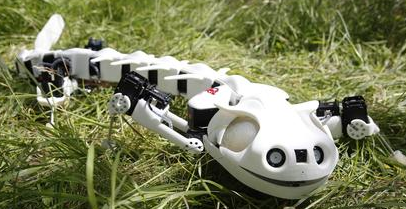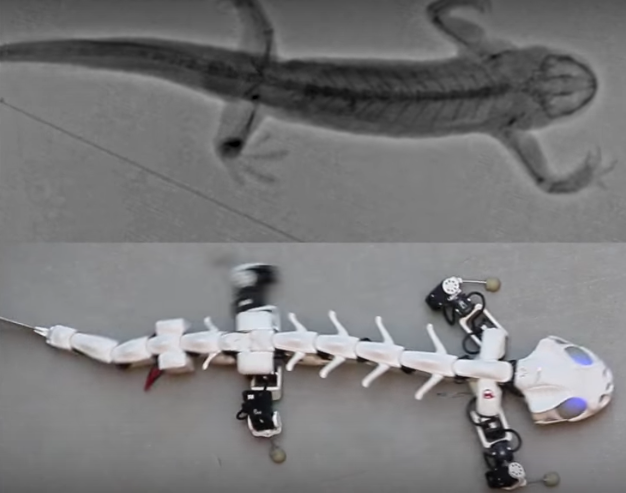Robot mimics vertebrate motion
July 7, 2016

Pleurobot (credit: EPFL)
École polytechnique fédérale de Lausanne (EPFL) scientists have invented a new robot called “Pleurobot” that mimics the way salamanders walk and swim with unprecedented detail.
Aside from being cool (and a likely future Disney attraction), the researchers believe designing the robot will provide a new tool for understanding the evolution of vertebrate locomotion. That could lead to better understanding of how the spinal cord controls the body’s locomotion, which may help develop future therapies and neuroprosthetic devices for paraplegic patients and amputees.

Pleurobot mimics Salamander. Neurobiologists say electrical stimulation of the spinal cord is what determines whether the salamander walks, crawls or swims: At lowest level of stimulation, the salamander walks; with higher stimulation, its pace increases, and beyond some threshold the salamander begins to swim. (credit: EPFL)
Simulating the 3D motion of the salamander’s locomotion requires exceptional precision. The Biorobotics Laboratory scientists started by shooting detailed x-ray videos of the salamander species Pleurodeles waltl from the top and the side, tracking up to 64 points along its skeleton while it performed different types of motion in water and on the ground.
Auke Ijspeert and his team at EPFL then 3D-printed bones and motorized joints, and even created a “nervous system” using electronic circuitry, allowing the Pleurobot to walk, crawl, and even swim underwater.*
Ijspeert thinks that the design methodology used for the Pleurobot can help develop other types of “biorobots,” which could become important tools in neuroscience and biomechanics.
The research, described in the Royal Society journal Interface, received funding from the Swiss National Center of Competence in Research (NCCR) in Robotics and from the Swiss National Science Foundation.
École polytechnique fédérale de Lausanne | A new robot mimics vertebrate motion
* In the design process, the researchers identified the minimum number of motorized segments required, as well as the optimal placement along the robot’s body, to replicate many of the salamander’s types of movement. That made it possible to construct Pleurobot with fewer bones and joints than the real-life creature — only 27 motors and 11 segments along its spine (the real animal has 40 vertebrae and multiple joints, some of which can even rotate freely and move side-to-side or up and down).
Abstract of From cineradiography to biorobots: an approach for designing robots to emulate and study animal locomotion
Robots are increasingly used as scientific tools to investigate animal locomotion. However, designing a robot that properly emulates the kinematic and dynamic properties of an animal is difficult because of the complexity of musculoskeletal systems and the limitations of current robotics technology. Here, we propose a design process that combines high-speed cineradiography, optimization, dynamic scaling, three-dimensional printing, high-end servomotors and a tailored dry-suit to construct Pleurobot: a salamander-like robot that closely mimics its biological counterpart, Pleurodeles waltl. Our previous robots helped us test and confirm hypotheses on the interaction between the locomotor neuronal networks of the limbs and the spine to generate basic swimming and walking gaits. With Pleurobot, we demonstrate a design process that will enable studies of richer motor skills in salamanders. In particular, we are interested in how these richer motor skills can be obtained by extending our spinal cord models with the addition of more descending pathways and more detailed limb central pattern generator networks. Pleurobot is a dynamically scaled amphibious salamander robot with a large number of actuated degrees of freedom (DOFs: 27 in total). Because of our design process, the robot can capture most of the animal’s DOFs and range of motion, especially at the limbs. We demonstrate the robot’s abilities by imposing raw kinematic data, extracted from X-ray videos, to the robot’s joints for basic locomotor behaviours in water and on land. The robot closely matches the behaviour of the animal in terms of relative forward speeds and lateral displacements. Ground reaction forces during walking also resemble those of the animal. Based on our results, we anticipate that future studies on richer motor skills in salamanders will highly benefit from Pleurobot’s design.